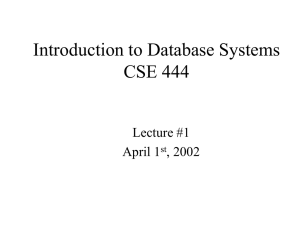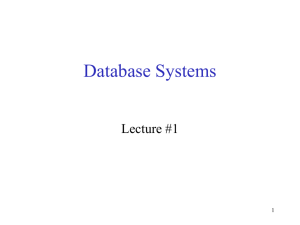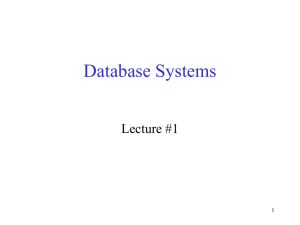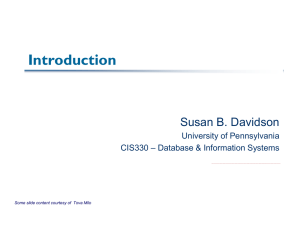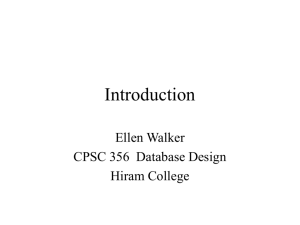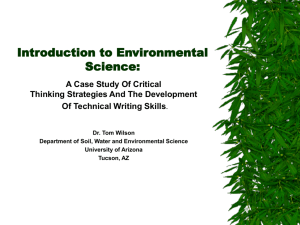Lecture 1
advertisement
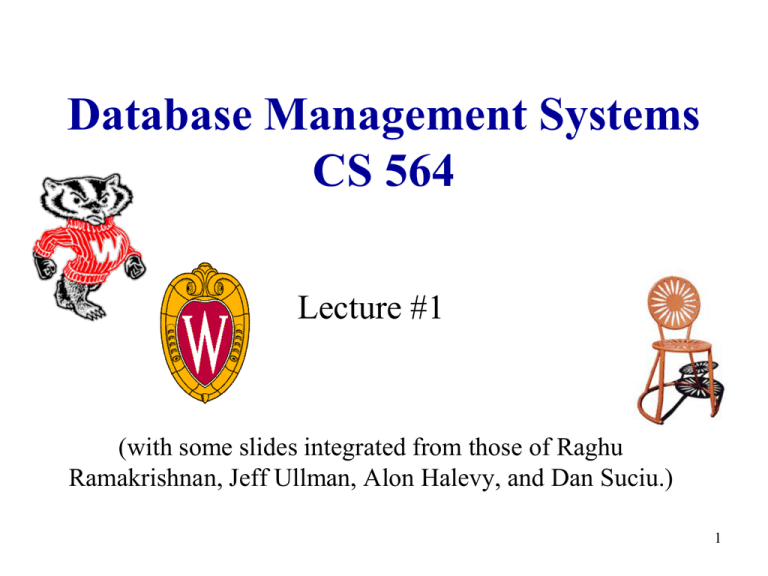
Database Management Systems CS 564 Lecture #1 (with some slides integrated from those of Raghu Ramakrishnan, Jeff Ullman, Alon Halevy, and Dan Suciu.) 1 Yes. This is the Room for CS 564 • We moved from Humanities 1111 • All future lectures/discussions will be in this room • Please sit a bit closer to the screen, so that I don’t have to shout • Room doors are usually locked; I will unlock 15 minutes before each class 2 A Bit about Myself Born in Vietnam Grew up in a fishing village Nice name: AnHai Doan “Nghe An” “Hai Phong” Until my brother as born as HaiAn Doan 3 Vietnam Hungary US High school in Vietnam Undergrad in Hungary – had lot of beers – learned seven languages – Hungarian, English, C, C++, Ada, Pascal, PL/I When iron curtain fell back in 1993, one of the firsts to reach US to study 4 Wisconsin Seattle Illinois Wisconsin Masters at Wisconsin-Milwaukee Ph.D. at Washington-Seattle – where I failed to take “CS 564” started at Univ of Illinois-Urbana – with corn, cow, campus In Madison since 2006 – where the four major food groups are 5 Random Comments from Students • Take instruction seriously, … gave lots of really excellent dating advice • All in-class examples revolve around beer • His accent is very annoying … • His accent is great. It’s so hard to understand that I’m forced to concentrate in lectures … • His accent is a bonus feature of the class. Prepared me to work in Silicon Valley • I now love databases …When I own Oracle, I will pay you back. 6 What is this Course about? • Numerous applications must deal with a lot of data • They typically put data into a database • The database will be managed by a system called database management system • Applications then interact with this system to access and use the database 7 An Illustration Database management system DB 2 DB 1 App 1 App 2 DB 3 8 Questions • What form should the data be in? – way back in 1970s, people suggest to store data in tables – so each database is a set of tables Students ID First Name Last Name 1 Barack Obama 2 George Bush Addresses ID City State 1 Washington DC Washington DC 2 Dallas TX 9 Questions • What form should the data be in? – each table can be thought of as a relation in the mathematical sense – so such a database is referred to as a relational DB Students ID First Name Last Name 1 Barack Obama 2 George Bush Addresses ID City State 1 Washington DC Washington DC 2 Dallas TX 10 So the management system is called a relational database management system (or RDBMS for short) Database management system DB 2 DB 1 App 1 App 2 DB 3 11 Since the 1970s, RDBMSs have been studied intensively, and have taken over the world • • • • • It is now a corner stone of the modern world Powering virtually all data-intensive apps 20B industry Bought island in Hawaii Since then new types of data have emerged – that would not be very well suited to be modeled as tables 12 • New types of database management systems have also emerged – eg NoSQL systems • But RDBMSs remain foundational and pervasive, and will be so in the future • This class focuses on RDBMSs – – – – we will learn how to design a relational database how to store it in an RDBMS how to use an RDBMS look into the internals of RDBMS 13 • Lessons that you learn in this class will carry over to newer types of database management systems • You will learn fundamentals of managing a large amount of data – critical as the world is becoming increasingly data centric • Good for you when you go applying for a job – many jobs require knowing how to use RDBMSs • It’s fun 14 • If you are interested in more data managment stuff – CS 764: gory details about RDBMSs – CS 784: newer types of data and how to manage them (beyond RDBMSs) 15 Course Logistics 16 Prerequisite • Must have data structure and algorithm background – CS 367 is a must; CS 537 might be useful • For the project – lot of programming will be required – in a high-level language of your own choosing (or rather your team’s choosing) – could be Java, C, C++, Perl, Python, etc. – must know how to build a Web based application or be willing to learn 17 Textbook – There is no ideal textbook, unfortunately – Database Management Systems, by R. Ramakrishnan and J. Gehrke, third edition – Database Systems: The Complete Book, by GarciaMolina, Ullman and Widom, second edition – The best thing to do is to attend the lectures, make notes, and read the lecture notes – Consult the textbooks – If you do this, you will be fine 18 Course Format • For all students – two 75-min lectures / week – project: programming, 4-5 stages, may include some basic homework questions – a midterm and a final exam • Attending lectures on Wed/Fri is important • We also use the Mon slots occasionally for make-up lectures • So if you can’t make Monday 2:25-3:15, do not take the class 19 • In fact, for next week I’m traveling on W and F • So we will have a make-up lecture on Monday, Jan 26 20 Lectures • Lecture slides in ppt format will be posted shortly before or after the lecture – are to complement the lectures • Many issues discussed in the lectures will be covered in the exams – hence try to attend lectures regularly • Will not cover ALL materials on the slides – attending lectures will tell you which is covered and which is not 21 Project • Select an application that needs a database • Build a database application from start to finish • Significant amount of programming • Will be done in stages – you will submit some work at the end of each stage • May have to show a demo at semester end 22 Project Groups • Project will be done in group of 3-4 students – a lot of work, difficult to design so that one person can do all – learn how to work in a group: valuable skills – groups are like broccoli, they are good for you • Try to form groups as soon as possible – can start by posting requests on Piazza • There will be a deadline later for forming groups • If you have not formed groups by then – we will help assign you to groups 23 More on Grouping • All group members receive same grading • If someone drops out, the rest pick up the work 24 Exams • Midterm & final – will be announced shortly – check dates and make sure no conflict! • There may be some brief review before each exam • If you have conflicts – do let us know in advance • The Uncle problem 25 Tentative Grading Breakdown • • • • Midterm: 25% Final: 35% Project: 40% Will attempt to grade on an absolute scale as much as possible – not on a curve 26 Contacting the staff ... 27 Staff & Office Hours • Instructor: AnHai Doan • TAs: – Avinaash Gupta – Harneet Singh • See class homepage for office hours, contact information 28 Communications • class homepage – www.cs.wisc.edu/~anhai/courses/564-sp15 • mailing list: compsci564-1-s15@lists.wisc.edu – vitally important! – make sure to check it regularly for new announcements • Piazza: will be set up shortly • If you have a question/problem – – – – talk to people in your group first post your question on Piazza email TA go to office hours to talk to TA or instructor 29 Now onto database studies ... 30 At the Beginning • A program typically consists of code + data • Eg, need to sort 1000 numbers – 2, 4, 6, 8, 1, 13, 9, ... • Store these numbers in an array • Write some code to sort • Both code + data are stored in memory, and mixed together – this was typical sort programs you learned in CS 367 31 • Eventually people realized that – the data part could be huge; maybe not sorting 1000 numbers, but 1 trillion numbers – this posed serious problems: what happened if the data doesn’t fit into memory? – another issue is that many apps may want to access and do the same thing with data – should we write duplicate codes for each of these apps? – maybe we should factor out common code – thus the motivation for databases and DB management systems 32 An Illustration Database management system DB 2 DB 1 App 1 App 2 DB 3 33 Another Motivating Example • Suppose we want to store, manipulate, and query information about: – – – – students courses professors who takes what, who teaches what 34 Application Requirements • store the data for a long period of time – large amounts (100s of GB) – protect against crashes – protect against unauthorized use • allow users to query/update: – who teaches “CS 367” – enroll “Mary” in “CS 564” 35 • allow several (100s, 1000s) users to access the data simultaneously • allow administrators to change the schema – add information about TAs 36 Trying Without a DBMS • Why Direct Implementation Won’t Work: • Storing data: file system is limited – size less than 4GB (on 32 bits machines) – when system crashes we may loose data – password-based authorization insufficient • Query/update: – need to write a new C++/Java program for every new query – need to worry about performance 37 • Concurrency: limited protection – need to worry about interfering with other users – need to offer different views to different users (e.g. registrar, students, professors) • Schema change: – entails changing file formats – need to rewrite virtually all applications • Better let a database system handle it 38 What Can a DBMS Do for Us? • Data Definition Language - DDL • Data Manipulation Language - DML – query language • Storage management • Transaction Management – concurrency control – recovery • Think buying a plane ticket! Can you do it without a DBMS? 39 What Can a DBMS Do for Us? • Automate a lot of boring/mundane operations on data – so that we don’t have to program over and over – so that we can write complex data manipulations in just a few lines, so that we can concentrate on app logics • Make execution very fast – so that it scales up to very large data sets • Make concurrent access/modification possible – so that many users can use the data at the same time 40 Building an Application with a DBMS • Requirements modeling (conceptual, pictures) – Decide what entities should be part of the application and how they should be linked. • Schema design and implementation – Decide on a set of tables, attributes. – Define the tables in the database system. – Populate database (insert tuples). • Write application programs using the DBMS – way easier now that the data management is taken care of. 41 name category Conceptual Modeling name cid ssn Takes Course Student quarter Advises Teaches Professor address name field 42 Schema Design and Implementation • Tables: Students: SSN 123-45-6789 234-56-7890 Takes: Name Charles Dan … Category undergrad grad … SSN 123-45-6789 123-45-6789 234-56-7890 Courses: CID CSE444 CSE541 Name Databases Operating systems CID CSE444 CSE444 CSE142 … Quarter fall winter • Separates the logical view from the physical view of the data. 43 Querying a Database • Find all courses that “Mary” takes • S(tructured) Q(uery) L(anguage) select C.name from Students S, Takes T, Courses C where S.name = “Mary” and S.ssn = T.ssn and T.cid = C.cid • Query processor figures out how to answer the query efficiently. 44 Query Optimization Goal: Declarative SQL query Imperative query execution plan: sname select C.name from Students S, Takes T, Courses C where S.name=“Mary” and S.ssn = T.ssn and T.cid = C.cid cid=cid sid=sid name=“Mary” Students Takes Courses Plan: tree of Relational Algebra operators, choice of algorithms at each operator 45 Database Industry • Relational databases are a great success of theoretical ideas. • Big DBMS companies are among the largest software companies in the world. • Oracle • IBM (with DB2) • Microsoft (SQL Server, Microsoft Access) • Others • $20B industry. 46 The Study of DBMS • Several aspects: – Modeling and design of databases – Database programming: querying and update operations – Database implementation • DBMS study cuts across many fields of Computer Science: OS, languages, AI, Logic, multimedia, theory... 47
